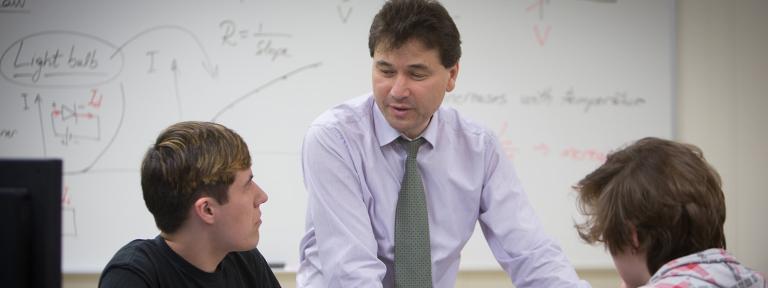
The Society of Physics Students (SPS)-A Section at Kettering is walking a fine line lately - the line between making science a dry, boring subject and finding the entertainment value in it. They have put together a program of physics experiments to share with elementary, junior high and high school students to show the fun side of science.
They presented the program for the first time to students at St. Pius Catholic School in Flint, Mich. Six of the nine SPS members in Kettering's A Section demonstrated scientific principles such as momentum and diffraction through a series of hands-on activities.
"We developed the program to ignite an interest in math and science in students from sixth through eighth grades," said Josh Rea, of Temperance, Mich., and SPS president. The group is eligible to receive grants from the national SPS organization for community service projects, he added.
To make Physics "phun" for the students at St. Pius School, SPS came up with some demonstrations using everyday objects. To illustrate momentum they used a small car with a marble in a cup on top. The car was pushed forward and a lever popped the marble into the air. Because the marble and car were traveling at the same velocity, the car caught the marble in the cup as it rolled forward. Then the group added weights to the car to increase its velocity. Because it was moving faster than the marble in the air, the marble dropped behind the car missing the cup.
"We tied this demonstration to the importance of wearing seat belts in a car," said Rea, "comparing the passengers in the car to the marble. Both are traveling at the same velocity, and if the car stops quickly the passengers are still moving unless they are restrained," he said.
To explain why parents encourage beginning bike riders to "ride faster because it's easier," SPS used a bike wheel on handles to illustrate the effects of angular velocity and rotation. "The faster the wheel spins the harder it is to move it off its rotational axis," said Rea.
They were also able to explain the conservation of angular momentum, or why figure skaters slow down when they spread out their arms and speed up when they pull their arms in toward their bodies. They put St. Pius students on a spinning base (like a lazy susan) and had them hold books in their outstretched hands. First they spun them around slowly then had them pull their arms in to their chests, and of course, they spun faster.
SPS resorted to Optics for the "ooh and ahh" effect, said Rea. The groups used lenses, mirrors and prisms with a laser to show diffraction of light. First they shone a flashlight through a single slit in a piece of paper. The result is that one only sees a slit of light. When a laser is shone through the slit it spreads out in an entire line of color, creating a diffraction pattern.
The SPS members involved in the program at St. Pius included:
Josh Rea, of Temperance, Mich.,
Kurt Webb, of Manistee, Mich.,
Christopher Ocedek, of Swartz Creek, Mich.,
Herman Orgeron, of Stafford, Va.,
Scott Duhaime, of Troy, Mich., and
Ken Meyer, of Rochester, Mich.
SPS will present their program again March 21 at a junior high in Grand Blanc, Mich. In addition to working with primary and secondary students, SPS also offers Physics tutoring for Kettering students enrolled in Physics 1 and 2.
Written by Dawn Hibbard
810-762-9865
dhibbard@kettering.edu